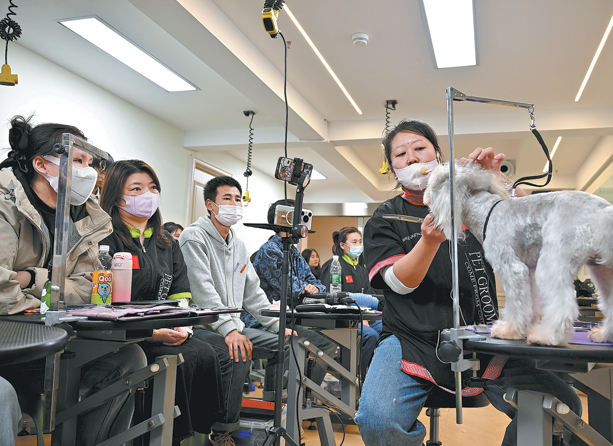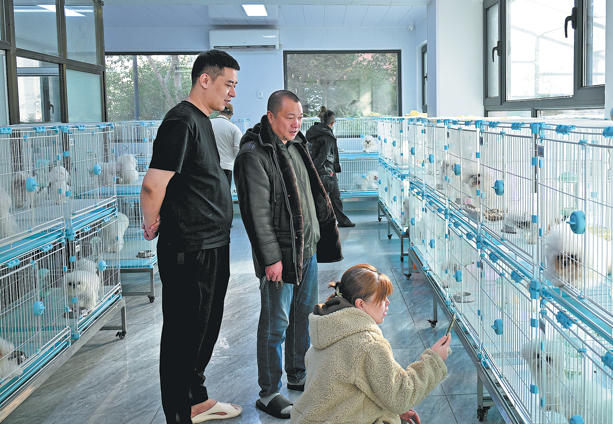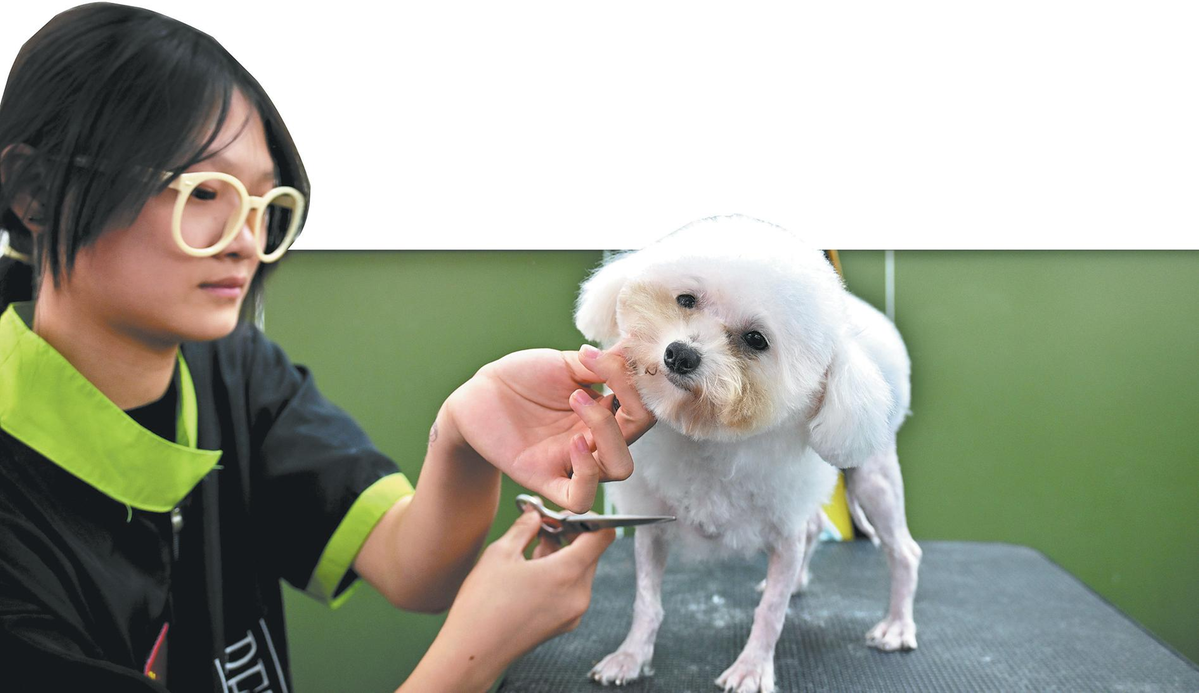
If economic development were a symphony, the sounds of Anshan, Northeast China's Liaoning province, would be shifting from the piercing clangor of steelmaking to the meows and woofs of pet cats and dogs.
Fueled by strong nationwide demand for pets, the city is reimagining its future, leaving its old industrial past behind. As the country enters the upcoming 15th Five-Year Plan (2026-30) period, Anshan is aiming to establish itself as the pet-breeding capital of China.
The rise of Anshan has long been tied to the fortunes of Ansteel Group Corp. However, the steelmaker — facing overcapacity, declining demand and intensified competition in the 1980s — experienced a prolonged downturn that resulted in widespread layoffs.
Many of the displaced steelworkers sought alternative ways to earn a living. Han Zongli, 61, was one of them. In the 1980s, after graduation, he became a steelworker, but a year later, he found himself unemployed.
Scrambling for income, Han opened a barber shop — and that's when everything changed.
One day, a customer came in with a pet dog, arousing Han's interest so much that he immediately went to a nearby pet market and bought a female puppy for 800 yuan ($112).
Later, she gave birth to three pups of her own, which Han sold for 3,000 yuan each.
Han found himself in the pet-breeding business and he wasn't alone. A lot of unemployed steelworkers saw the same opportunity, and a growing pet-related industry provided them with a lifeline. It also helped stitch together the city's social fabric in new ways.
'Furry flood'
The scale of Anshan's pet breeding sector today is substantial. More than 30,000 residents are currently involved in breeding, and trade and services for purebred dogs and cats, according to the city's agriculture and rural affairs bureau. Over 500,000 dogs and cats comprise the base animal population, with Anshan now supplying about 70 percent of China's pet dogs.
Han Wei, deputy director of Anshan's bureau of agriculture and rural affairs, said that the city is now the largest pet-breeding base in China.
Last year, 1.5 million dogs and cats were bred and sold. This year, the number is expected to hit 2 million.
And the industry is spreading in a furry flood to other cities in Liaoning — Shenyang, Dalian, Liaoyang and Fushun.
As of last year, Liaoning, with Anshan as a hub, had a pet industry that encompassed breeding, pet-related products, healthcare and cultural activities, and employed more than 150,000 people. The sector generates more than 30 billion yuan annually.
ALSO READ: Pet lovers from across the world connect via RedNote
Early on, Han Zongli focused on purebred Pekingese and Maltese. "It was quite profitable," he said. "A puppy could be sold for 30,000 yuan."
He has kept a sharp eye on customer preferences and stayed a step ahead of market trends. Han profited from the popular Pekingese breed in the 1980s, then Pomeranians in the 1990s, followed by the rise of large breeds such as Samoyeds and Tibetan Mastiffs after 2000, and then a shift toward smaller breeds, such as Bichons and Yorkshire Terriers around 2012.

In recent years, he has focused on in-demand Yorkshire Terriers and other breeds, selling between 30 and 50 puppies per day.
"Choosing the right breed is the key to making a profit," Han said. "You'll never fail if you understand the rhythm. It follows a 10-year cycle."
These days, Han operates two breeding facilities of more than 1,000 square meters each that house nearly 100 dogs.
Shang Xuefeng, executive president of the Anshan Pet Chamber of Commerce and the founder of a local pet company, is part of the booming industry. In the early years, Shang focused on dog breeding and sales, then shifted to pedigree cats in the past decade.
"My journey began with a lifelong love for animals — it was passion that drove me," said Shang.
His company has been operating for 17 years. Currently, it boasts nearly 500 "Golden Plus White Series Munchkin" cats. In 2024, it bred over 2,000 of the breed, ranking first nationwide in the number of Munchkin cats.
Seizing opportunities
The pet-breeding industry, especially dog breeding, has undergone a dramatic shift in public perception since the 1980s. Back then, pet breeding was not considered respectable, Han said. It was seen as an "unprofessional" activity and dismissed as a frivolous hobby or lazy endeavor.
"When I first started raising dogs, I felt it was somewhat embarrassing and carried a social stigma," Han said. "But now, my perspective has completely changed. Today, dog breeding is not only viewed as a serious venture but also as a source of pride — a real profession."
Han's children have also entered the industry. His son and daughter joined his pet-breeding business after they graduated from university, and his nephew is a veterinarian for the Anshan Public Security Bureau's K-9 unit.

Han's dog-breeding business is increasing its reach into the international market. He envisions Chinese-bred dogs expanding their presence around the globe — something that's already happening.
The descendants of French Bulldogs bred in Anshan are being sold in South Korea and the United States, while other breeds are finding their way into Russian homes.
Demand varies: South Korean traders frequently purchase premium breeds like Bichons for specialized breeding, while Russian buyers typically focus on midrange breeds.
ALSO READ: Pet care in China goes high tech
Han believes the industry holds great potential, and he encourages young people in Anshan to seize the opportunities available. "I hope the youth will develop this industrial chain and help Anshan establish its own branded dog food — as well as expand into the manufacturing of related supplies, such as dog cages," he said.
For him, the vision of Anshan people selling Anshan-brand dog food represents both a practical opportunity and a point of local pride.
Game changer
A new generation is driving the emergence of an industrial chain related to the sector. Wang Chuang, a 36-year-old entrepreneur, is one of those transforming Anshan from a regional breeding hub into what he envisions as the nation's pet industry capital.
Wang started out as a breeder in 2006, with no family wealth or industry connections. "I was a country kid. Everything I have came from the trust of people in Anshan," he said.
After making a name for himself in animal breeding and stud services, Wang's humble beginnings have grown into a multi-pronged business empire. He now has a breeding base of 10,000 square meters with around 1,000 dogs.
Through a cooperative model, Wang has united about 10,000 local breeders, helping them to not only raise dogs but to pool their purchasing power, adopt standardized feeding practices and, crucially, connect with buyers across the nation directly via his platform, cutting out layers of middlemen.
He also sees bigger opportunities. In 2019, he launched his own brands — Zhuojue cat litter, and Jiaxiang pet food and treats.

The true game changer, however, has been vertical integration. Wang is set to open a pet complex of 15,000 sq m in Anshan's economic development zone by this month that will include a "pet Walmart", a massive live-animal house, a breeding base, and a livestreaming hub.
Backing this expansion is a landmark joint venture with Liaoning Xin'an Holding Investment, a State-owned company in the city. Wang, who is executive director of the partnership, holds a 51 percent stake, with the city retaining 49 percent. This alliance provides capital, credibility and a mandate to standardize the fragmented industry.
"With the government involved, every product we sell must be 100 percent compliant. We're setting the standard," Wang said.
Greater exposure
Guo You, a 62-year-old retired steelworker, buys calcium supplements for his dogs at Wang's pet supply store. He has a monthly pension of around 5,000 yuan, but breeds dogs because he wants to keep active in retirement.
Guo began breeding dogs less than three years ago, focusing on small breeds like Shih Tzus and Yorkshire Terriers — a path that isn't easy. Like many breeders in Anshan, he struggles to get fair prices for his dogs, even those with good pedigrees.
"The ones with great looks still don't sell for much here," Guo said. "That's our biggest challenge."
The problem, Guo believes, lies in limited exposure. He currently sells through local dog markets and to occasional individual buyers, including livestreaming resellers who take a cut, so the pool of potential customers remains small.
Guo's story illustrates the gap between local breeders and major urban markets such as Shanghai, Beijing and Hangzhou, Zhejiang province, where demand is greater and prices are higher.
"If 10 people see a litter, versus 10,000, the price is definitely going to be different," Wang said.
His answer is the "01 Pet" app, which is scheduled to launch alongside his new complex. Named to symbolize starting from "zero" and aiming to be "No 1", the app is designed as a one-stop shop for live animal trading, breeding services and supplies. Wang says it addresses a critical gap in the market.
"Existing e-commerce platforms aren't built for live pets," he said. "We're creating an exclusive platform, which the industry lacks."
ALSO READ: Many paws driving pet economy growth
His vision extends far beyond the city. "We shouldn't just be playing in a small circle in Anshan," he said. "My dream is to see Chinese pets go global."
With 20 years in the pet industry, Wang has made a bold call for nationwide collaboration. He wants to consolidate talent and resources to build a stronger, more expansive pet platform that can compete not just locally, but globally. His vision is to go beyond what a small local team can accomplish alone.
"I hope people across China — those who can benefit from my experience and resources — will come to Anshan and explore how we can work together," he said.
Development plan
The success of Anshan is powered by rising pet ownership among urban Chinese, a trend partly driven by broader societal shifts, such as an aging population and declining marriage rates. Pet companionship is becoming more important and is unlocking the immense potential of the pet industry.
China's urban pet population reached 120 million last year — a 2.1 percent year-on-year increase — with the market for dogs and cats valued at 300 billion yuan annually, according to the 2025 China Pet Industry White Paper.
Mayor Wu Kaihua said in Anshan's 2025 government work report that the city will vigorously expand its pet economy, strengthen specialized markets and create a robust pet industry ecosystem. The speech was an official signal to the pet industry that the government will steer it toward systematic development and standardization.
Under Anshan's pet industry development plan, for the next five years the industry will be developed around the framework of "One Belt, One Base, and Three Parks". The city plans to create a dedicated pet economy belt along Qianshan West Road and a national-standard breeding base for dogs and cats in its Tiexi district.
The three specialized parks are: a pet supplies park in the county-level city of Haicheng, a pet food park in Tai'an county, and an ornamental fish park in Anshan's economic development zone.
As intelligent companion animals, cats and dogs are not mere commodities — they are beloved family members. With ownership expanding rapidly, authorities see an urgent need to fill the gaps in industry standards and laws and regulations.
In December, the technical committee for standardization of companion animals was established to provide guidance for pet disease prevention and control, diagnosis and treatment, boarding, training, and breeding management.
Anshan's Tiexi district last year launched "Anxin Pet", a digital platform that integrates blockchain technology to create unique digital IDs for pets.
READ MORE: Pet economy purrs ahead as cat, pooch cafes spread
The idea is to have traceable records of a pet's breed, health and origin. It will build a full life-cycle ecosystem for pets, covering breeding, medical care, testing and transportation.
"This marks a shift from low-end live animal sales to high-quality service offerings, with the goal of bringing transparency and trust to live pet transactions while supporting Anshan's goal of becoming a national hub for standardized pet e-commerce," said Shang from the Anshan Pet Chamber of Commerce.


